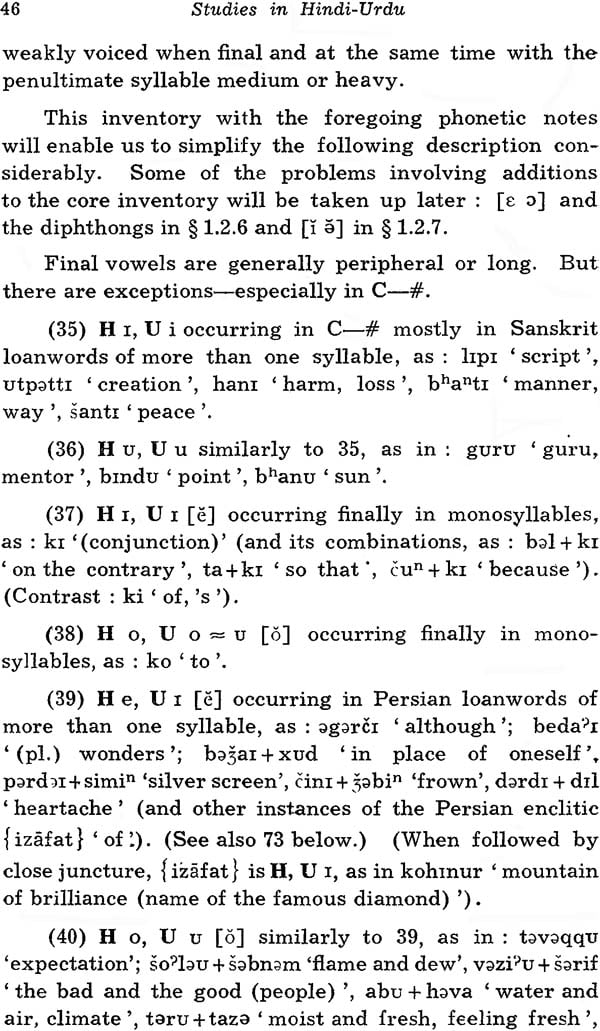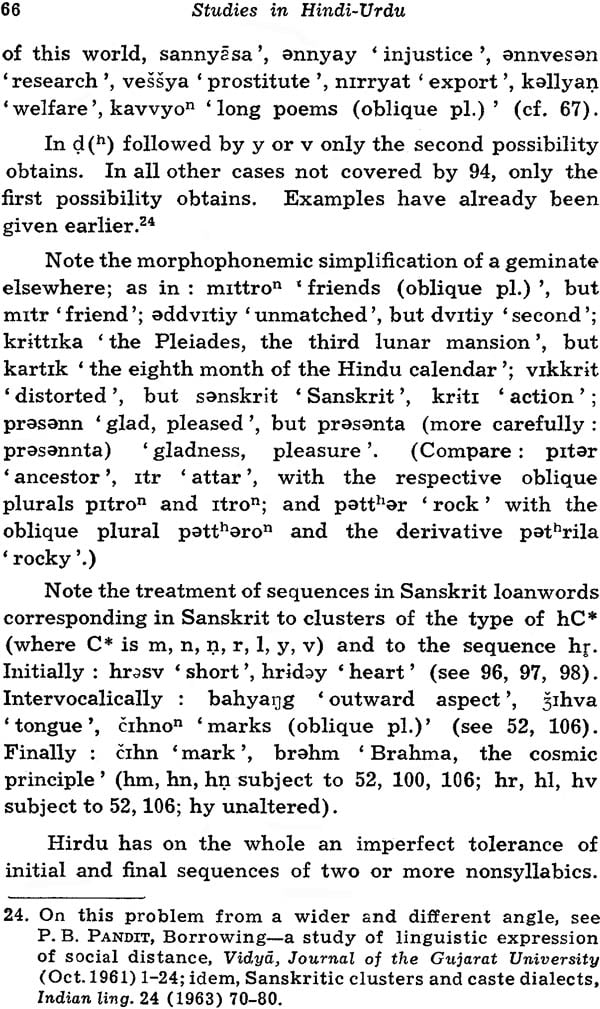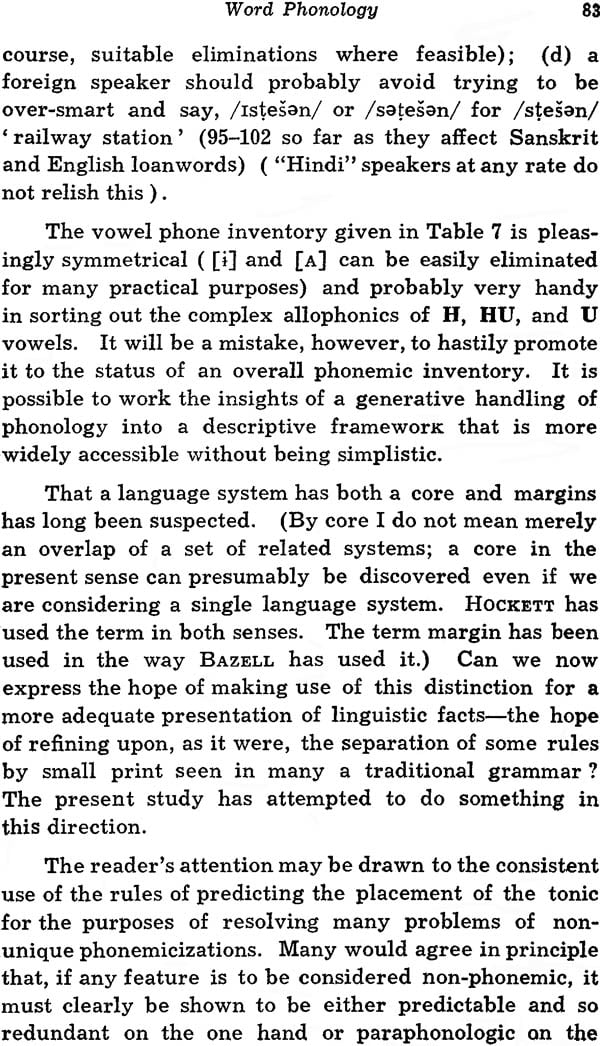
Studies in Hindi-Urdu (Introduction and Word Phonology)
Book Specification
| Item Code: | NAL995 |
| Author: | Ashok R. Kelkar |
| Publisher: | Deccan College Postgraduate and Research Institute |
| Language: | English |
| Edition: | 1968 |
| Pages: | 99 |
| Cover: | Paperback |
| Other Details | 8.5 inch X 5.5 inch |
| Weight | 120 gm |
Book Description
On the 15th of October 1964 the Deccan College celebrates the centenary of its main Building, and curiously enough this period coincided with the Silver Jubilee of the Postgraduate and Research Institute which, as successor to the Deccan College , started functioning from 17th August 1939 when members of the teaching faculty reported on duty. When I suggested to members of our faculty the novel idea that the century should be celebrated by the publication of a hundred monographs representing the research carried on under the auspices of the Deccan College in its several department they accepted the suggestion. These contributions are from present and part faculty members and research scholars of the Deccan College, giving a cross-section of the manifold research that it has sponsored during the past twenyfive years. From small beginning in 1939 the Deccan College has now grown into a well development and developing Research Institute and became a national centre in so far as Linguistic, Archaeology and Ancient Indian History, and Anthropology and Sociology are concerned. Its international status is attested by the location of the Indian Institute if German Studies (jointly sponsored by Deccan College and the Goethe Institute of Munich), the American Institute of Indian Studies and a branch of the Ecole Francaise d’Eextreme-Orient in the campus of the Deccan College. The century of monographs not only symbolizes the centenary of the original building and the silver jubilee of the Research Institute, but also the new spirit of critical enquiry and the promise of more to come.
The aim of this and future studies in Hindi-Urdu is to provide a comprehensive framework for further field-work and discussion that could lead to a definitive description of contemporary standard Hindi-Urdu (or Hirdu for short). I am painfully aware that this presentation is based on insufficient fieldwork and insufficient tapping of secondary sources, i.e. previous descriptive and prescriptive studies. I have had no access to informants from Pakistam Pakistan or to published work written in Urdu, for example. But repeated experience of frustrating discussions based on idiolect studies- especially in phonology-has convinced me that some framework is better than none, and that the whole gamut of linguistic systems that could possibly come under the rubric of contemporary standard Hindi or Urdu needs to be studies together.
In Figures 3 and 4and the discussion pertaining to them I am certainly sticking my neck out, but a fresh statement was overdue for some years even if it then comes in for correction and further revision by more competent hands.
The arrangement and the style of presentation is intended to be in consonance with the essentially exploratory and preparatory nature of this study. This involves a certain repetitive and loose-knit quality, for which I crave the methodological purist’s indulgence. The reader will notice that I have resorted to the practice of giving minimally and sub-minimally contrasting pairs for phonemic and morphophonemic distinctions. This practice is rather out of fashion now, but deserves to be revived.
It is difficult to, write about Hindi-Urdu without exacerbating sensibilities. I may simply plead here that my motive has only been the uncovering, recording, and systematizing of facts. If I have said something that either pleases or annoys, that is a wholly unintended result. I have of course recorded educated speech in its unguarded moments too and duly labeled such alternants appropriately. Again showing either approval or disapproval of these is furthest from my intentions.
Substantial portions of the phonological part (ch.1) were presented in an earlier version at the Winter Seminar of Linguistics, Kurukshetra University, December 1963. I have benefited from the comments of my co-participants. I have pestered numerous colleagues and students at Agra (1958-62), Poona, and elsewhere for data, some of it semi-cooked. I must specially mention Dr. Murari Lal Upraite (Agra University), Dr. Amba Prasad Suman (Dakshin Bharat Hindi Prachar Sabha, Madras), dr. Gyan Chand Jain (Hamidia College, Bhopal), and Mr. Ram Prakash Dixit (University of California, Berkeley). Indeed, in the last two cases the debt comes near to being collaboration at some points. My views, however, often differ from theirs-which may be ascertained respectively from: Dr. Jain’s Lisani mutalae (“Linguistic studies”), Karachi: Anjuman Taraqqi-e-Urdu, 1964 and Mr. Dixit’s The Segmental phonemes of Contemporary Hindi, University of Poona and Deccan College), Dr. M. A. Mehendale (Deccan College), Dr. P. B. Pandit (Universty of Delhi), Dr. Masud Husain Khan (Osmania University, Hyderabad, Andhra Pradesh), Dr. Devishankar Dwivedi (Vikram University, Ujjain, M. P.), Mr. Stuart McGregor (Cambridge University), and Mr. Shri Krishna Swamy were kind enough to go through an earlier version of the completed manuscript and make useful comments. I have pleasure in expressing mu sense of gratitude to all of those and my predecessors in the fields of phonology in general and of Hindi-Urdu phonology in particular. More specific acknowledgements have been made in the footnotes.
The Problem Stated.
Descriptive linguists, in their justifiable anxiety to have a relatively homogeneous body of parole on which to base their study of the language system, tend to rely on idiolects as starting points. Evettually, however, the starting point has to be left behind. An idiolect is after all a point of reference that is extrinsic to the symbolic culture system as such: an idiolect is a biographical accident. With many other languages this does not involve a serious practical limitation. Contemporary standard Hindi-Urdu however, consists of a gamut of intergraded variations that need to be studies together- within a single framework.
This is particularly true of phonology. Here the tolerance of the listeners for variety s very great. Purists who will haggle over points of grammar and vocabulary are cheerfully unaware of the wide variety of pronunciations disguised by uniformities of orthography. The study by Gumperz and Naim, which refuses to concentrate on some single variety and treat it as a separate unit and taken instead all of them together as the unit of study, is therefore a welcome departure. It is, however, only a departune and needs to be followed up. Before we can go into the methodological preliminaries, it is necessary to go over some familiar ground and unsnarl the tangle of labels like Hindi, Urdu, Khari Boli, and the rest.
Hindi-Urdu in its contemporary social-and-geogra-phical setting.
If we leave out the Gypsy dialects, Afghoni, Sinhalese, and the Dardic-Kashmiri group, modern Indo-Aryan (or Indic) dialects probably form a dialect continuum (Figure 1) that displayed variations from village to village and from caste-group to caste-group and that exhibits one notable peculiarity. It reenters upon itself, and this results is linguistic discontinuities, which suddenly bring home to us, as were the amount of diversification that the Indo-Aryan subfamily has undergone and the complicated nature of the history of this diversification. This total continuum is farmed out, so to say, among some selection koins that have received the stamp of state recognition and contemporary printed literature. There are Hindi-Urdu, Panjabi, Sindhi, Gujarati Marathi, Oriya, Bengali, Assamese, and Nepali. Barring Hindi-Urdu, each of the rest (as also Kashmiri) has a clearly defined homeland-the area over which the koine dominates coincides with the geographical extension of the dialect-cluster which is the linguistic matrix of that koine. If we say that Bengali, Gujarati, Tamil, and the rest are the regionally “marked” koines of Asia (to use the convenient cover term for India, Pakistan, Nepal, Bhutan, and Ceylon), Hindi-Urdu (or Hirdu as I propose to call it from now on) is, much like its predecessor Sanskrit and its contemporary rival English, the regionally “unmarked” koine of south Asia. When its homeland is defined, it is done negatively as the residual area left by the regionally “marked” koines. This is sometimes called Hindustan or Upper India or, with some inexactitude, North India. When we need some handy ethic name for the people of this area, further excisions are made- namely the Rajasthanis, the Panjabis (Lahnda and Panjab speaker), possibly the Biharis (the state of Bihar includes Magahi and Maithili areas and Maithili areas and a part of the Bhojpuri area), the Paharis (as a vague rubric for Indo-Aeyan and Tibeto-Burman Panjab and Uttar Pradesh), and of course the Tribal or Adivasi groups (in the Malvi, bundeli, Bagheli, Chhattisgarhi, and Magahi areas). For the remainder there is no obvious name. The very artificiality of the terms U.P. (whether the old United Provinces of Agra and Oudh or the new Uttar Pradesh, the “northern region”) and Madhya Pradesh (the “central region” –a descendant not of the ancient Madhya Desh but the British Central Provinces and Central India Agency) is revealing.
| Preface | vii | |
| Chapter 0. | Introduction | 1 |
| 0.0 | The Problem stated | 1 |
| 0.1 | Hind-Urdu in its contemporary socil-and-geographical setting | 2 |
| 0.2 | Hindi-Urdu in its historical linguistic-and-literary setting | 11 |
| 0.3 | Methodological preliminaries | 16 |
| 0.4 | Recommendations on nomenclature | 19 |
| Chapter 1. | Word phonology | 21 |
| 1 | Introductory | 21 |
| 1.1 | A Sketch of the core system of word phonology | 22 |
| 1.1.0 | Inventory of phonemes | 22 |
| 1.1.1 | Contrasts illustrated | 23 |
| 1.1.2 | Phonetic correlates | 23 |
| 1.1.3 | Highlights of the distributional statement | 28 |
| 1.2 | A Detailed survey of problem areas | 29 |
| 1.2.0 | Introductory | 29 |
| 1.2.1 | The Poblem of the marginal loanword consonants | 31 |
| 1.2.2 | Te Problem of nasal consonants and nasalization | 33 |
| 1.2.3 | The Problem of the retroflex flaps | 39 |
| 1.2.4 | The problem of the glottal fricatives | 42 |
| 1.2.5 | The Problems of an enlarged vowel inventory | 45 |
| 1.2.6 | The Problem of the semivowels | 52 |
| 1.2.7 | The Problem of geminates and other clusters | 64 |
| 1.2.8 | The Problem of atomic short vowels | 73 |
| 1.2.9 | A Selection of sporadic correspondences | 75 |
| 1.3 | A Consolidated picture | 79 |
| 1.4 | Some wider implications of the present study | 81 |
| Addenda and corrigenda | 86 |









